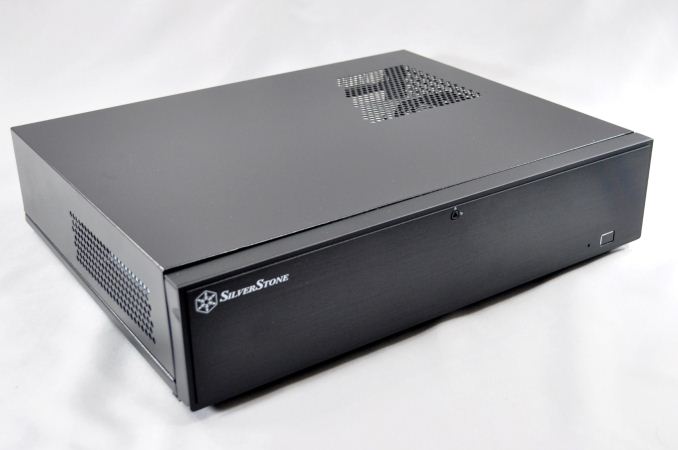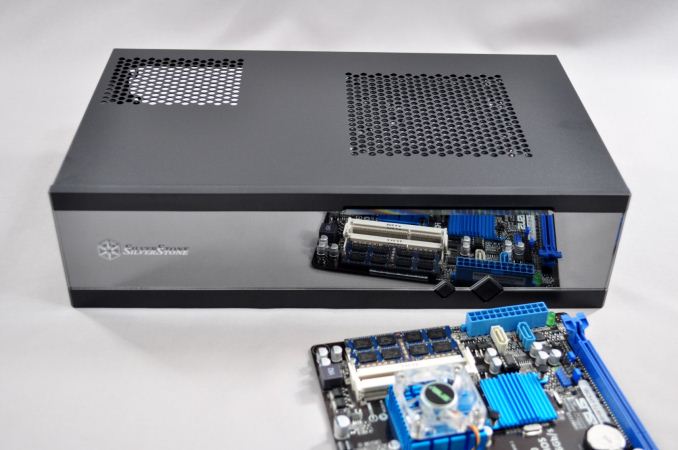SilverStone ML04 & ML05 Slim HTPC Cases Review
by E. Fylladitakis on April 18, 2014 2:30 PM EST- Posted in
- Cases/Cooling/PSUs
- HTPC
- SilverStone
- desktops
Final Words
Slim desktop cases are a special category of products that typically do not adhere to design conventions and thus their size, flexibility, and compatibility depends on the designer/manufacturer alone. It would be a mistake to compare them directly with other case designs that have been made with entirely different goals in mind. As they are designed to fit into cabinets and match A/V equipment, their compact proportions dictate that sacrifices need to be made. With both the Milo ML04 and the Milo ML05, Silverstone is trying to balance just about everything; compatibility with common components, upgradeability, aesthetics, and a reasonable price tag. The size of the cases will inevitably come with certain limitations, mostly on the compatibility and upgradeability fronts.
These limitations are not extremely significant with the Milo ML04, as it can hold Micro-ATX motherboards, common ATX PSUs, and 3.5"/5.25" drives. There are limitations regarding their size and only a small number of drives may be installed, but such components are common and relatively cheap. It is not difficult to build a very good HTPC inside the Milo ML04, and you can even install a modern low profile GPU, such as an R7 250 or GT 640, for some casual gaming (and improved video codec support). With an R7 250 installed, the system should be capable of handling 4K video material as well. Considering the 0.016 cubic meters this case occupies and the height of only 105mm, that's not bad at all.
Despite the fact that the Milo ML04 is their entry-level slim HTPC case, Silverstone paid attention to many little details and features. For example, it is possible to lock the power button on the door to prevent children from pressing it, and a simple dimmer has been installed to lower the intensity of the power-on LED if the user finds it annoying. The company also reinforced the chassis and tried to make it as versatile as possible, allowing end users to choose their ideal configuration. However, each component selection sacrifices something else. For example, if you install an optical drive, you cannot use the same cage to install a 3.5" or 2.5" drive. If you choose to go with a 2.5" drive on the plastic cage, you cannot install a 3.5" device there as well. Moreover, if you choose to go with a full height expansion card by using a riser, you severely limit the height of the CPU cooler.
Aesthetics are a subjective matter but we feel that certain things could be improved. It is understandable that Silverstone focused all of their attention on the faceplate, as it will be the only directly visible aspect if the Milo ML04 is installed inside a cabinet. However, in any other scenario, the body of the Milo ML04 will look entirely out of place. Moreover, some other details could be improved, such as the massive gap between the plastic faceplate and the metallic chassis, which is obvious once the door opens. We have to stress that this is an entry-level HTPC case however, retailing for $74.99, so we cannot ask too much from it.
Silverstone reduced the proportions of the Milo ML05 even more, creating a tiny design that is very discreet. Although it's not as small as the Antec ISK 110, the Milo ML05 is a good compromise between minimum proportions and the more versatile Milo ML04. As the Milo ML05 is smaller than the vast majority of A/V equipment, it is most likely intended for a minimalistic environment comprised of just a tiny HTPC and a nice TV, rather than to match other A/V equipment. The tiny size of the Milo ML05 however reduces upgradeability and versatility even more. Aside from the obvious motherboard size limitation, as only Mini-ITX boards may be installed, only SFX PSUs will fit -- tightly. If the multipurpose bracket is used for an optical drive or extra cooling, the installation of a 3.5" drive is not possible at all. Even if a 3.5" drive is installed on the multipurpose bracket, it will reduce the maximum height of the CPU cooler by several milimeters.
It is very easy to be lured by the very low retail price of the Milo ML05, which currently sells for just $39.99 incl. shipping. However, the low retail price is misleading, as the components required to build such a small system can be quite expensive. The SFX PSU is not much of a problem, as a low-capacity unit should not cost more than $50. If you wish to include an optical drive, however, you can only use a slot-loading slim SATA drive that will cost $69.60. If you skip the optical drive, you may install additional cooling or drives, or nothing at all; in any case, you will end up with a useless slot across the faceplate of the system, as there is no way of hiding it.
Building a budget HTPC in the Milo ML05 is still possible. It is not difficult to find a board with an integrated CPU for less than $100 (our demo Asus C8HM70-I/HDMI retails for $78.99) and a quality SFX PSU for $54.99. Add some RAM and a mechanical 2.5" HDD and you will probably manage to have a fair HTPC for less than $250 total. This is not all that bad for a case that occupies less than one fourth the volume of a Mini-ITX case designed to take high-performance GPUs, such as the Obsidian 250D.
If you want more power and/or features, with a proper selection of components the Milo ML05 can become a small powerhouse; however, the price will start increasing rapidly as well. The optical drive alone will cost over $60 and an 1150/FM2 based board with a good CPU will increase the budget by at least a hundred dollars. If you want to add a good low profile GPU, that will be yet another hundred dollars more. Then you will have to seek a low profile CPU cooler and most likely you'll want to install an SSD as well, bringing up the cost of the system from about $250 to about $650-700. While it may be interesting that you can build a rather powerful system within such small proportions, it can be a costly endeavor and we do not really recommend it, unless the intended use of the system is much more than just typical HTPC functions.
Overall, the Silverstone ML04 and ML05 are reasonable cases, and provided you're aware of their limitations -- and are willing to put a bit more time into researching the best components as well as assembling the system -- they can work well as entry-level HTPCs. If you want something more versatile, you'll generally sacrifice on size at the least, and perhaps cost as well, while devices that are even smaller will have to cut additional features. As a low priced alternative to other HTPC enclosures, the ML04 and ML05 fill a niche and should keep their intended users happy.













39 Comments
View All Comments
johnny_boy - Saturday, April 19, 2014 - link
The ML04 looks alright (not great, not terrible) but the ITX ML05 is terribly ugly. Diamond buttons? Big plastic strip across the front? There's a serious lack of nice, affordable, ITX cases especially in this HTPC form factor.Dave12311231 - Saturday, April 19, 2014 - link
I would like to use the Milo ML05 with a 19V DC connector equipped motherboard and a Broadwell or future AMD system. This would negate the cables from an internal PSU whilst still having a very small case, hopefully cheaper than a NUC system overall.jabber - Saturday, April 19, 2014 - link
These are NOT great looking cases.C'mon people try harder!
Alan G - Saturday, April 19, 2014 - link
Well they do look better than the traditional cable box that comes courtesy of your provider!I've built several HTPCs for family and friends over the past six months and these cases should be OK. You don't need any graphics cards with new CPUs (I use Intel but I'm sure the same is true with AMD on board graphics). In addition HTPC systems are not energy demanding and I've got one in a Lian Li PCQ-27 case which is passively cooled. Temperatures under operating conditions with only the Intel stock cooler run just over 30C which is fine. The review is correct about the lack of choices in PSUs for these applications. I've been using Seasonic G-360s which work just fine and are silent.
Thanks for this posting and continue to find some small HTPC case to review.
irusun - Saturday, April 19, 2014 - link
Agree.And especially the "mirror" front on the ML05 sounds awful... why would I want that sitting under/next to my TV bouncing all sorts of reflections?
jtd871 - Monday, April 21, 2014 - link
Silverstone now offers the recent ML06, which is the same chasis as the 05, but dumps the acrylic front panel for anodized aluminum like the 04.irusun - Saturday, April 19, 2014 - link
I'm aware others have had similar comments, and I'm sincerely not trying to hurt E. Fylladitakis feelings or question his technical competence, and I'm rooting for him to succeed, but he really needs help with the writing. It's pretty obvious that english is not his first language, and it results in wordy paragraphs, weird phrasings (at times it sounds like it was written by a bot), and it's just plain difficult to follow at times. I expect better writing at Anandtech.irusun - Saturday, April 19, 2014 - link
I'm surprised there's so little mention of "noise" in HTPC case reviews where noise is one of the primary issues of concern. I understand what was stated in the article about not being able to quantify results above background room noise, but how about some subjective comments just based on experience. Were the supplied PSUs "quiet"? Do the cases offer any advantages or disadvantages for building a quiet system? It's understood that there are an infinite combination of coolers and fans and PSUs, but I would expect some further thoughts on the noise front, even if they're just informed opinions.Daniel Egger - Monday, April 21, 2014 - link
When building an HTPC noise is completely in your hand. Even if the case contains fans you almost certainly don't want to use them without any sort of fan controller if at all. Getting a mainboard with enough 3 or even 4 pin connectors for controlling the fans is highly recommended. In my setup I connected the 2 case fans only to provide some general airflow through the case so the rest of the components will also receive some cooling (and the CPU fan blowing out at the top can run at the slowest level for a longer time) but they're setup to run at the lowest possible speed so they're inaudible unless you hold your ear right next to them. Before changing the fan controller setup they were blowing at full pace making some unacceptable amount of noise.Voldenuit - Sunday, April 20, 2014 - link
OK, I can understand why the ML04 doesn't have one, but wth didn't Silverstone design the ML05 with a GPU riser card to accommodate at least a medium to high end GPU? Even if a user opted not to turn their HTPC into a gaming device, this would open up the possibilities for more expansion cards that are not half height.